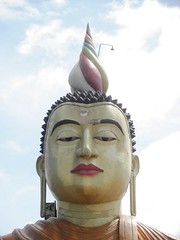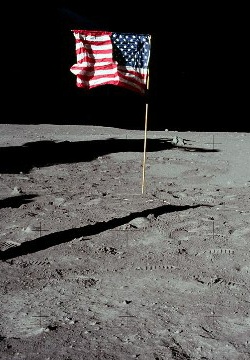I am on a personal quest to tell the world with well-reasoned arguments why Jaipur is the most overrated city in India. It is the third most popular tourist destination in India, though I completely fail to see why. Though I have no issue with it ensnaring its legions of rich, fat, waddling oafs, I consider it my duty to prevent decent people from being deceived by the vast amounts of falsehood perpetuated by the travel industry. This quest shall resume momentarily, but I put it on hold for a day-trip to somewhere actually enjoyable.
I caught a public bus to the town of Amber. Knowing that the bus would become excessively crowded, the conductor actively encourages early-mounting passengers to climb through a small opening in the plexiglass and crowd into the driver's cab. This affords excellent views through the wide front window,and thanks to the density of bus traffic on what is not quite a two-lane highway it also serves as a highly convenient and quick means of transferring between buses in the event of a head-on collision. I continue to take public buses because I have computed that my life is in fact worth no more than the fare of 7 rupees, a sum comparable to what one might find in the crusty leave-a-penny tray at Wendy's.
When we got to Amber I was rewarded to a spectacular view of a massive stone palace crawling up the ridge with a fort high above it. Amber was previously the capital of this kingdom until the Rajas built Jaipur in the 1700's. I imagine they must have relocated for the same reason Indian TV continues to show Indian rap videos: some people just hate culture. Below the palace are several pleasure gardens sitting like islands in a placid lake. Oh, did I say "lake"? I meant "big-ass hole full of dust". Rajasthan has no water anymore. My personal army of turbaned serfs carries water in steel urns from the Himalayas so that I don't have to flush my toilet with goat milk.
I climbed up and went within the palace complex, which was incredible. The Raja's private quarters in particular were superb, being a finely carved patio-like structure adorned with mosaics of silver and mirrored glass. From atop its walls and turrets were great views of the valley and town below, but I was not even near the top. No, the fort is of course strategically located atop the tallest, steepest, most barren, heaven-forsaken upthrust of rocks and dirt for miles around. Nevertheless I made the ascent, not least because I had a free entrance coupon. The fort itself was unremarkable and I was treated to a truly unenlightening tour of its famous cannon foundry by a strange man who knew relatively little about cannon-forging but was quite enthusiastic in the brief tap-dance he gave after each "explanation". The fort's saving grace is that it contains Jaivana, the world's largest wheeled cannon, a behemoth twice the height of a man, requiring 100kg of gunpowder to fire and allegedly boasting a range of 35km. The various Rajput principalities were notoriously belligerent, but this is just spiteful. In an age before explosive shells, this would really just serve to completely ruin one person's day at a time.
The fort's other saving grace is an attribute it shares with any semi-abandoned building in India: it is overrun with monkeys. However these are not the same monkeys one sees everywhere in the Ganges region, which I believe are called rhesus macaques. These are big, long-tailed monkeys with fur the color of unwashed rice and wizened black faces. Though they spend much of their time sitting around and holding their feet, they also like to sprint after eachother, galloping headlong through swinging iron gates and scattering packs of simultaneously amused and terrified schoolchildren. Monkeys are the universal entertainers. Everyone likes monkeys. If we were serious about promoting cross-cultural understanding we would unleash packs of monkeys in the United Nations General Assembly. These monkeys, though sometimes moved to excitement, are much more laid-back and seemingly introspective. Whereas a rhesus macaque's general demeanor expresses a desire to do a backflip and throw a tambourine at a baby, the large black-faced monkeys look as though they should be blowing rings off a fat blunt and saying "You know what's really real, man? Being a monkey."
My explorations complete, I descended the hill and once again jogged to hop into a moving bus. I found myself taken yet again into the heart of Jaipur, the "Pink City". Let me tell you about Jaipur. The first time I came to the Pink City I was actually excited. The rarely-effusive guidebooks I consult spoke wonders of the sprawling, vibrant bazaars and the uniform pink paint of the vast old city. This is bullshit of the first order. First of all, the paint is now applied only to the facades on heavily-trafficked streets in a blatant ploy to retain the city's moniker. Worse, the paint is of very low quality and is not even pink. Too cheap to spring for real pink paint, the city has purchased vast quantities of an orangey-pink slop that many of you may recognize as the color of that one awful crayon in the pack that always managed to stay twice as long as the others. Based on the haphazard application of the color, its greasy appearance, and the ease with which it seems to wipe off, I would surmise that the city is in fact painted with this very crayon. As for the bazaars, claimed to be "some of the finest in all of Asia", this is just false. Though it is certainly possible to buy just about any saleable good at a shop here including some very fine textiles and jewellery, the bazaars are most emphatically not "vibrant". The large divided roads that pass through it carry an incessant traffic of cars and city buses, stripping the orange-slopped shops of what little charm they may have had, while foot traffic between merchants is impeded by the ubiquitous fleets of parked motorcycles.
Having perused the bazaars to my satisfaction I proceeded to the historical sights. I began with Jaipur's "architectural masterpiece" the Hawa Mahal, or Palace of Winds, so named for its hundreds of lattice windows. The Palace of Winds ain't shit. The famed latticework is uninspired and generally sloppy, while its interior decor is as moving as a heap of peat. I scoff at the Palace of Winds. The City Palace, a complex housing the Raja of Jaipur, is a little better but outrageously overpriced. Though the silly-turbaned servants mug amiably for tourists and the grand hall is grand, one cannot help but notice that the current Raja is keeping all the best parts for himself, the looming seven-storey palace in which he resides being strictly off-limits and ringed by very serious-looking armed guards. You can however see two gargantuan silver water urns which according to Guinness are the largest silver objects in the world. You can also marvel at palace decor composed largely of geometric patterns made out of weapons, because as I've mentioned, the Rajasthani kingdoms were belligerent as hell.
By far the best sight in Jaipur is the Jantar Mantar, a walled garden of collossal stone astronomical instruments designed by the Raja who built Jaipur, some of which are truly bizarre and ingenious and cannot be seen in any other observatory. If the words "azimuth" and "declination" get your pants wet, or if the phrase "massive gnomon" gives you a massive gnomon, this is the place for you. For the unscientific it is still highly enjoyable, because even if like me you have little desire to compute the hour angles of celestial bodies, it is still a garden of very large and very strange things.
It's time to return to my cushy hotel. Sure, the bathroom soap may be called Mysore Rose, which sounds like the after-effect if I were victimized in a late-night encounter with rohypnol and an oboe, but I have hot water and cable TV. Time for some motherfucking cricket.
Nov 6, 2009
Subscribe to:
Post Comments (Atom)









All I want to do with my life is smoke blunts with monkeys. Stay fresh.
ReplyDelete